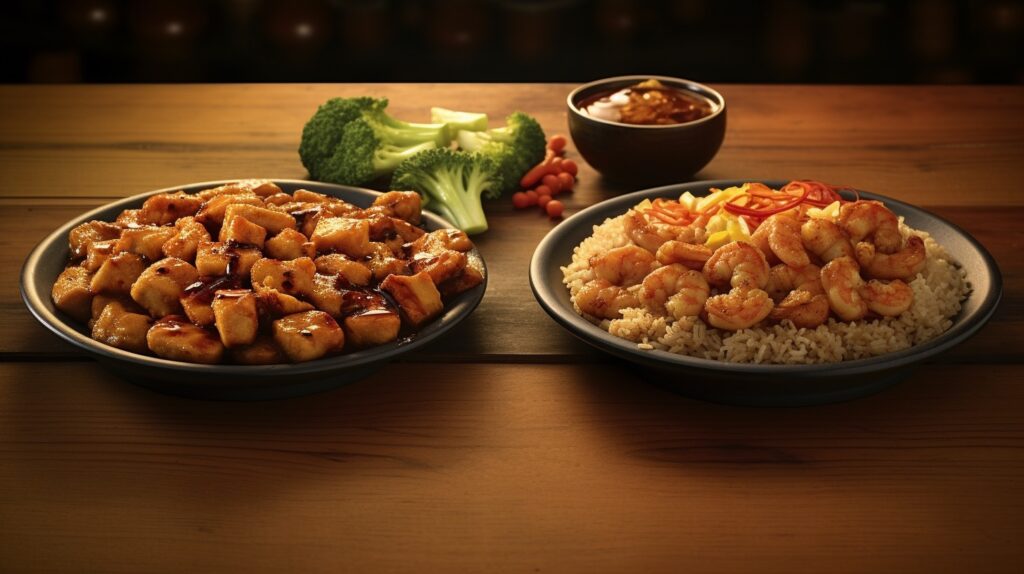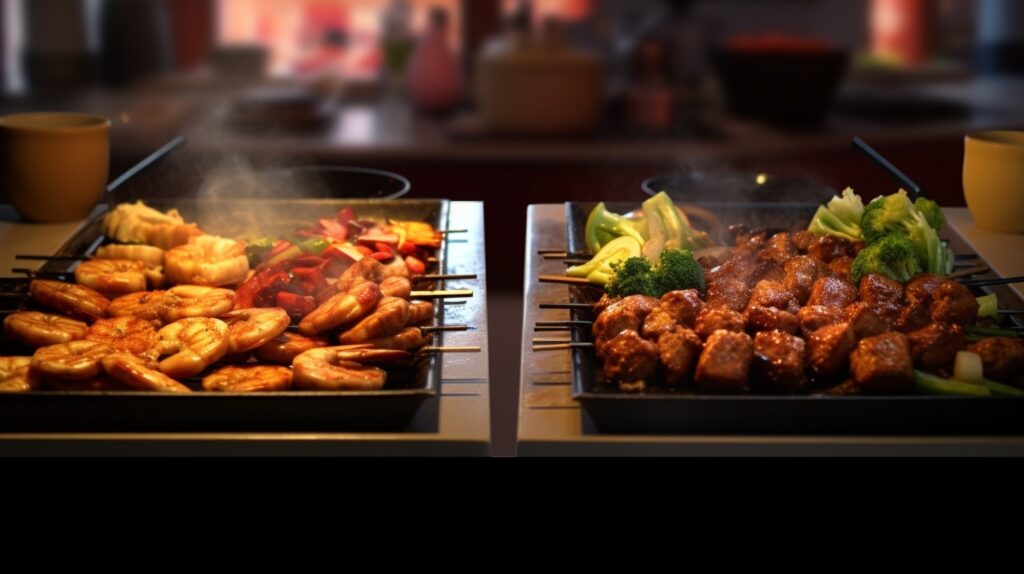Japanese cuisine is renowned worldwide for its aesthetics, the emphasis on seasonality, and above all, the exquisite balance of flavors. Two culinary methods that encapsulate the philosophy of Japanese cooking are Hibachi and Teriyaki. Both have gained global popularity due to their unique attributes. However, they’re often misunderstood or interchanged. Let’s dive deep into these two culinary techniques, exploring their origins, characteristics, and differences.
What is Hibachi?
Originating from Japan, Hibachi is a style of cooking that employs a high-heat, metal grilling method, typically on a type of barbecue known as a ‘hibachi grill.’ The term ‘hibachi’ translates to ‘fire bowl,’ a reference to the design of the traditional cooking equipment.
Hibachi-style cooking is known for its theatrical, performance-based presentation. The chef typically cooks the meal in front of the guests, turning the process into an engaging experience filled with skillful chopping, flipping, and even fiery stunts.
Hibachi cuisine incorporates a wide array of ingredients, including seafood, beef, chicken, rice, and an assortment of fresh vegetables. It’s known for its savory, subtly smoky flavor profile, usually brought out by soy sauce, sake, or mirin used in the cooking process.
What is Teriyaki?
Teriyaki, on the other hand, is a Japanese cooking method where foods are broiled or grilled with a glaze of soy sauce, mirin, and sugar. The word ‘teriyaki’ is derived from ‘teri,’ meaning luster given by the sweet soy glaze, and ‘yaki,’ which refers to the cooking method of grilling or broiling.
Unlike Hibachi, Teriyaki is less about the method of cooking and more about the sauce. The sauce’s sweet-savory flavor, along with the tenderizing effect it has on the meat, has made Teriyaki a favorite in many households and restaurants worldwide.

Main Differences
Cooking Technique
Hibachi and Teriyaki are vastly different in their cooking techniques. Hibachi is a high-heat grilling method, while Teriyaki involves broiling or grilling with a distinctive marinade.
Presentation Style
Hibachi is known for its theatrical cooking presentations, often served in restaurants where food is prepared directly in front of customers. In contrast, Teriyaki does not emphasize presentation and is more focused on the flavor imparted by the marinade.
Sauce Use
Teriyaki revolves around the use of a specific sweet-savory sauce, while Hibachi cooking typically employs a variety of sauces, including soy sauce, ginger sauce, or even just simple seasoning.
Flavor & Taste
Hibachi cooking results in a smoky, savory flavor, subtly enhanced by the sauces used. The ingredients’ natural tastes are pronounced due to the high-heat grilling method.
Teriyaki’s flavor is distinctive and dominated by its signature sauce – sweet and glossy, with a savory undertone from the soy sauce. The sugar in the Teriyaki sauce caramelizes during cooking, imparting a slightly smoky, sweet edge to the dish.

Nutrition Comparison
| Hibachi (average serving) | Teriyaki (average serving) | |
|---|---|---|
| Calories | 350-400 kcal | 420-470 kcal |
| Fat | 10-15 g | 10-20 g |
| Sodium | 500-700 mg | 800-1000 mg |
| Protein | 20-25 g | 25-30 g |
| Carbohydrates | 30-40 g | 45-60 g |
Please note that these nutritional values can vary significantly based on the specific ingredients and quantities used.
Difference in use
Hibachi chicken vs teriyaki chicken
Hibachi Chicken is traditionally cooked on a high-heat grill or griddle, known as a ‘hibachi’. It’s often prepared simply, with a seasoning of salt, pepper, and perhaps a light soy-based sauce. This method results in a slightly smoky flavor with the chicken maintaining a firm and juicy texture.
On the other hand, Teriyaki Chicken is marinated or glazed with teriyaki sauce—a sweet and tangy sauce made from soy sauce, sake or mirin, and sugar. The chicken is typically grilled or pan-fried, resulting in a glossy, caramelized exterior with a sweet and savory flavor. The texture of Teriyaki chicken is generally tender, but the outer layer can have a slight stickiness from the sauce.
Hibachi Chicken leans more towards a straightforward, smoky, and savory profile, letting the natural flavor of the chicken shine, while Teriyaki Chicken offers a complex interplay of sweet, tangy, and savory notes due to its signature sauce.
The Hibachi style gives a grill-kissed texture and the chicken pieces are often chunky, contrasting with the Teriyaki preparation where the chicken, often served as a fillet or thigh, gets a more silky, glazed finish.
Hibachi steak vs teriyaki steak
The method of preparation is no different from chicken above.
Comparatively, Hibachi Steak tends to be more about highlighting the natural, rich flavor of the beef, with a smoky, seared crust and a tender interior. Teriyaki Steak, with its signature sauce, offers a balance of sweetness and savory umami, with a glazed and slightly sticky exterior texture. Your choice may depend on your preference for a straightforward, beef-forward steak versus a steak with a sweet, tangy twist. Both versions provide a delightful way to enjoy a high-quality cut of steak.
25 Facts about Differences and Similarities
Fact 1: Origin
Both Hibachi and Teriyaki originated from Japan, reflecting the country’s rich culinary heritage.
Fact 2: Cooking Method
While Hibachi is a style of cooking (high-heat grilling), Teriyaki refers to a cooking technique involving a specific sauce.
Fact 3: Sauce Components
Hibachi dishes can be seasoned with a variety of sauces, while Teriyaki’s flavor signature hinges on the specific combination of soy sauce, mirin, and sugar.
Fact 4: Dish Versatility
While Teriyaki is primarily used for poultry and fish, Hibachi-style cooking can accommodate a wider range of ingredients, including seafood, beef, chicken, rice, and vegetables.
Fact 5: Cooking Equipment
Hibachi uses a specialized high-heat grill (also called a hibachi), while Teriyaki dishes can be prepared using standard grilling or broiling equipment.
Fact 6: Theatrical Element
Hibachi cooking often comes with a theatrical performance by the chef, while Teriyaki cooking lacks this showmanship aspect.
Fact 7: Dining Experience
Hibachi provides an interactive dining experience, where the food is usually cooked right in front of the guests. Teriyaki, however, is typically prepared in the kitchen, without the interactive element.
Fact 8: Popularity
Both Hibachi and Teriyaki are popular worldwide, particularly in the United States, due to their unique flavors and the global influence of Japanese cuisine.
Fact 9: Texture
Hibachi-style cooking tends to result in crisp, slightly charred textures due to the high-heat grilling. In contrast, Teriyaki dishes usually have a glossy, slightly sticky texture from the caramelized sugar in the sauce.
Fact 10: Cooking Time
Hibachi dishes often require rapid cooking due to the high heat, while Teriyaki dishes are usually marinated before cooking, requiring more preparation time.
Fact 11: Health Considerations
While both methods can be part of a balanced diet, Hibachi’s versatility allows for more low-carb and vegetarian options. Teriyaki, though, could have higher sodium due to the use of soy sauce.
Fact 12: Cultural Significance
Both Hibachi and Teriyaki hold important cultural significance in Japan, each representing different aspects of the country’s culinary tradition.
Fact 13: Adaptability
While both styles have been adapted to suit different cultures’ tastes worldwide, Teriyaki, due to its sauce-based nature, has been more extensively modified and used in fusion cuisines.
Fact 14: Pairings
Hibachi meals are often served with side dishes like fried rice, noodles, or stir-fried vegetables. Teriyaki dishes, on the other hand, are typically paired with steamed rice and pickles.
Fact 15: Commonality
Despite their differences, both Hibachi and Teriyaki are rooted in the principle of enhancing the ingredients’ natural flavors – a testament to the philosophy of Japanese cuisine.
Conclusion
In the great Hibachi versus Teriyaki debate, the winner really depends on personal preference. If you prefer a theatrical dining experience and the rich, smoky flavors of grilled meat and vegetables, Hibachi is your go-to. If you’re a fan of sweet-savory dishes with a lustrous glaze, then Teriyaki won’t disappoint.
Regardless of your choice, both Hibachi and Teriyaki offer a gateway to the intricate, flavorful world of Japanese cuisine – a world where tradition meets innovation, and simple ingredients transform into extraordinary culinary experiences.
